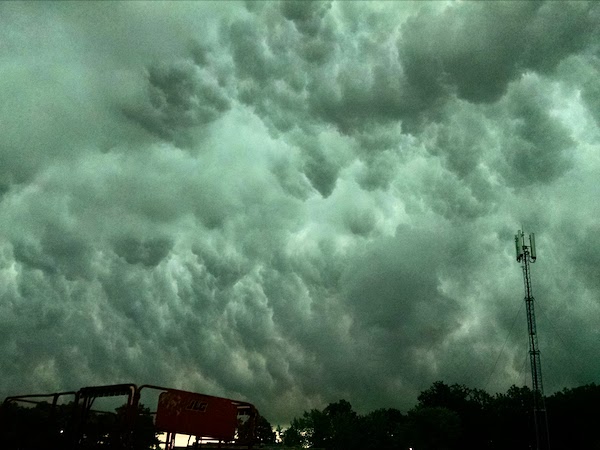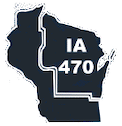Summer means working outdoor shows. Music Festivals, Casinos, EAA; these venues mean working long hours in sometimes adverse weather conditions and NOT in our usual locations. Take the extra steps needed to be sure you can work effectively and safely.
Besides the usual selection of tools, you may want to add extra personal gear in your kit: Raingear and a change of clothing in case of rain, spare shoes, a hat and sunblock, and so on. It may get extra hot (maybe a spare pair of shorts and T-shirt?), or pretty cool (especially after a rainstorm or after sundown) so plan accordingly. A layered approach allows you to add or subtract clothing when the weather changes, and it will! You may go from sun and temperatures in the 90's to rain, wind, and temps in the 40's in just a few hours. Wisconsin is like that!
 |
Did I mention that it rains? |  |
Dealing With the Heat
Wisconsin gets hot in summer. Our biggest outdoor events occur in July and August. Temperatures can be in the 90's or higher. Extreme heat can be dangerous, even life threatening. Excessive heat can cause heat exhaustion and then heat stroke. Heat exhaustion is dangerous and debilitating. Heat stroke is life threatening, a true medical emergency. Know the symptoms so that immediate action can be taken before it is too late.
Heat exhaustion: the body is trying to cool down but is failing. Symptoms include elevated body temp, excessive sweating, cool clammy skin, nausea, and muscle cramps. Get the victim cooled down immediately. Take them to a cool location out of the sun. Apply cool wet clothes and supply cool drinks. Don't be surprised if the victim is still nauseous next morning.
Heat Stroke: the body can no longer even try to cool down. It has failed. Sweating stops. Symptoms include high body temperature above 103°, hot dry skin, fainting, confusion, slurred speach, nausea and vomiting, and collapse. This is a life threatening condition medical emergency. Call 911 and get the victim to medical attention immediately! Meanwhile, get the victim out of the sun to a cool place. Apply cold wet cloths or get into a cold bath. The victim must be cooled down. They can no longer do it themselves. Do not force them to drink liquids.
For a more detailed information on heat related illnesses, how to recognize them and how to treat them, check out Warning Signs and Symptoms of Heat Related Illnesses.
Sunburn: often ignored, sunburn is a radiation burn caused by exposure to UV rays. Sunburn can affect skin of any color, and no one is immune. Any sunburn increases the chances of developing skin cancer. A typical first degree sunburn causes the skin to be red, dry, hot and painful. It is a fairly shallow burn. Deeper sunburn causes a second degree burn. It is still painful, and there is more damage as skin layers in the epidermis separate to form watery blisters. The worst, while rare at our latitudes, is a third degree sunburn. This is a deep burn reaching through the epidermis into the dermis. The skin will be dull or white and actually less painful, because the skin has died and nerve endings are destroyed. There may be scarring. Second and third degree sunburns require medical attention. Third degree burns will require surgery to remove the dead skin.
To avoid sunburn, cover up. Wear a wide brim hat and light, loose clothing that cover your arms and legs. If you opt instead for shorts and shirt sleeves, use sunscreen liberally, SPF 20 at a minimum; SPF 30+ is better. Reapply regularly, at least every two hours. Make sure it is recent, unexpired sunscreen than hasn't been stored in a hot car.
Getting There
Outdoor venues are often located away of other facilities. Know where you are going BEFORE you leave home. Don't count on your GPS; there may not BE a reliable street address to enter. Check out a Maps app. Get clear directions in advance.
Try to arrive early: fifteen to thirty min. at least. Traffic can be unpredictable. Allow time for surprises. Police often re-route traffic patterns to handle heavy show traffic. Don't assume it won't be different than you remember, especially as showtime approaches. Heavy traffic means traffic jams. We still expect you to be ON TIME. If it seems you might be late, call the cell phone number of the Steward, which also means you should get cell phone numbers BEFORE you leave home! If all else fails contact the B.A., but don't be surprised if he isn't there. He may be working the show you are headed for!
You may be working far away from a water source. Bring a bottle of water and sunscreen. Check weather in case raingear is in order. Bring the usual tools; gloves, a multi-tool or screwdriver and pliers, a crescent wrench, and maybe other tools needed to get the job done. You may find yourself building a stage before setting up the show. Lunch may be provided, but don't count on it. Lunch if not provided will be 1 hour long. Restaurants are often some distance away, so many people bring a bag lunch. Make sure you have a good cooler or bring non-perishable food. A sandwich left in a hot car is not good!
TAKE CARE OF YOURSELF! Working a show is challenging, and working outdoors adds an extra level of stress. Keep in mind the 6:2:1 rule of festival survival. Not easy to follow, but it should be a goal!
"At any given time, in the previous 24 hours you should have had six good hours of sleep, two solid meals, and one shower and clean clothes. You cannot substitute one for the other, six meals and two hours of sleep just doesn't work." (Dale Farmer, Stagecraft Mailing List)
If you are a new worker (an "overhire"), check out the "Permit Worker Information" packet for information and procedures.


